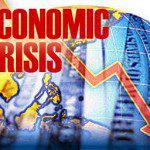The frequency of financial crises and recessions is quite high: on average, there is one crisis every 58 months (using data from the U.S. National Bureau of Economic Research). In other words, statistically speaking, we should expect the beginning of the next crisis in April 2015, which would end by March 2016. There are 8 possible scenarios that could cause the next crisis. Let’s take a look at each.
one crisis every 58 months (using data from the U.S. National Bureau of Economic Research). In other words, statistically speaking, we should expect the beginning of the next crisis in April 2015, which would end by March 2016. There are 8 possible scenarios that could cause the next crisis. Let’s take a look at each.
The above introductory comments are edited excerpts from an article* by Arturo Bris (imd.org) entitled Meltdown 2015?.
Bris goes on to say in further edited excerpts:
I do not want to be the bearer of ill tidings, but I think we should always wonder what the cause of the next crisis will be. There is no single episode of financial panic in the last 50 years that could not have been prevented. This time, let us look ahead, not react after the crisis.
What is there to worry about? There are 8 possible scenarios that could cause the next crisis, none more important or likely than the others. For some, prevention is straightforward. For others, I am not sure there is much we can do. Some of them represent imminent threats. A few are more long-term, less dramatic sources of instability. [Here they are in no particular order.]
1. Stock market bubble
Between June 2013 and June 2014, world stock markets returned 18% on average.,,however, most companies that announced results during 2014 disappointed markets, and for most large corporations, stock markets have reacted negatively to annual earnings. The reason is that, driven by excess liquidity and a lack of alternative opportunities, a lot of money has flown in to equity markets.
The Yale University economist and Nobel Prize winner Robert Shiller has shown that the gap between stock prices and corporate earnings is now larger than it was in the previous pre-crisis periods: 2000 and 2007. If markets were to return to their normal earning levels, the average stock market in the world should fall by about 30%.
2. Chinese banking system
Shadow banking (lending by anything other than a bank or outside the control of financial regulators) now represents more than 100% of GDP in the U.S., and about 70% in China. This is more of a problem in China than in the U.S., for two reasons.
- In China the banking sector is protected from foreign competition — only local banks are allowed to operate independently in the country. As a result, without any threat in a huge market, the biggest banks in the world are now Chinese. They are truly too big to fail.
- A big part of Chinese shadow lending goes to central government and provincial governments. Banking regulation in China is considered to be very stringent, but we know what happens when regulators become self-interested. Without a doubt, the next banking crisis will be triggered by a Chinese bank.
3. Energy crisis
An energy crisis now would not be caused by the scarcity of energy sources — quite the opposite. The development of fracking techniques and growing supply of gas in the U.S. have turned shale gas into a potent geopolitical weapon. If the US Congress were to allow energy exports, energy prices in the world would fall significantly. This would be great for companies, but would trigger geopolitical problems in Russia and West Asia. These countries rely on energy demand from western Europe and China, where energy costs are currently hurting competitiveness and where a cheaper alternative would be welcomed with open arms.
4. New real estate bubble
The conditions in 2005-07 that led to a real estate bubble are back: low interest rates, growing demand, and increasing real estate prices in some markets.
With respect to the demand factor, in current market conditions, the only attractive investments for institutional investors are real estate and equities. As a result, prices are increasing.
Between the end of 2007 and the end of 2013, according to the Bank for International Settlements, residential property prices increased by more than 80% in Brazil, 60% in China, and 15% in Canada, and there are also fears of a bubble in other countries such as Switzerland and the United Arab Emirates. Like any other bubble, it will only become one once it bursts. What is different in 2014 is that now central banks have a great tool to prevent real estate bubbles: Basel III and its countercyclical capital buffer.
5. Corporate failures
The norm for companies is now to be BBB-rated. In the US, there are only three firms that still are AAA-rated: Johnson & Johnson, Exxon Mobil and Microsoft. There were 61 in 1982.
Since interest rates are low, companies see the benefits in debt financing but this means that firms are also more sensitive to changes in interest rates. Typically a BBB rating is associated with a probability of default of about 4% in five years. Therefore, we should expect that in the next five years, about 16 companies in the S&P500 index will go bankrupt. One of them could be the new Enron.
6. Geopolitical crisis
From Nigeria to Ukraine, and from Syria to Venezuela, the world risk map shows too many hot areas where geopolitical events could trigger a world crisis. We should care about Ukraine or Syria because financial markets tend to overreact to political events and because, given the financial linkages among countries, negative sentiment in China will trigger a market collapse in the U.S. and vice versa. Let us not forget the lessons of the Great War (we are now commemorating the 100-year anniversary): the butterfly effect can be deadly in politics.
7. Poverty crisis
Over the last few decades the world has become richer and more prosperous. While the percentage of the population in absolute poverty is today at its lowest level ever, the absolute number of poor people continues to grow. In this context income inequality is one of the social battles that we need to fight but the problem with fighting income inequality is that the usual solutions (typically taxes) hinder the competitiveness of nations. This is one of the long-term crises that will require smart leadership to avoid inefficient solutions.
8. Cash crisis
There is too much money out there. It is the result of quantitative easing policies that central banks have followed. The excess liquidity in the system is concentrated among financial and non-financial firms. Citigroup has more than $487 billion in cash; Apple about $150 billion. It is paradoxical that, in some cases, banks and firms are so rich that they could buy entire countries (if one takes into account the total GDP minus government debt).
If the corporate sector were to unload such massive financial resources (as is their moral obligation) on to society, they would create hyperinflation and hence financial crisis but, otherwise, we are in a situation in which central banks print money that they will have to take out of the system later. We know how quantitative easing works, but we do not know how to exit from it.
Conclusion
While we can already see these 8 sources of a new coming crisis, the problem is that many obvious solutions that governments can implement would be detrimental to world competitiveness and could hinder local economies. More taxes, more regulation and more protectionism all create a more hostile environment to economic growth and competitiveness.
[Instead,] in order to avert the next crisis, and others after that,
1. Politicians and corporate executives should now look to:
- diversify,
- seek varied geographical presence,
- be flexible,
- be resilient,
- manage risk,
- cultivate and reward talent and
- improve their credibility in society
while
2. global leaders need to:
- boost their nations’ competitiveness and their chances of inclusive economic success by:
- investing internationally and
- making acquisitions in order to make their countries attractive to foreign capital
- and, after that, to make:
- employment,
- sustainability and
- social cohesion the top priorities of their nations.
Editor’s Note: The author’s views and conclusions in the above article are unaltered and no personal comments have been included to maintain the integrity of the original post. Furthermore, the views, conclusions and any recommendations offered in this article are not to be construed as an endorsement of such by the editor.
*http://www.imd.org/research/challenges/TC060-14-meltdown-2015-arturo-bris.cfm
If you liked this article then “Follow the munKNEE” & get each new post via
- Our Newsletter (sample here)
- Twitter (#munknee)
 munKNEE.com Your Key to Making Money
munKNEE.com Your Key to Making Money



I agree w/ SeniorD. I’ve been looking at S. America for expatting purposes. My only concern is…Do I want to be in a foreign country when the world economy tanks and SHTF. Everyone will blame the fiscal policies of the ‘worlds reserve currency’ and Americans abroad may become easy targets.
So, I may have to travel under a 2nd passport….. “Gutten tag!”
I look for an ever increasing number of retirees to move outside the USA to both increase their retirement dollars buying power and to relocate away from the growing tensions in the USA. This shift will allow them to maximize their quality of life while at the same time keeping their options open should they need to return to the USA for any number of reasons.